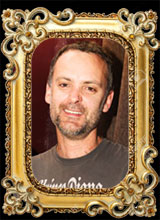
 |
 |
 |
 |
 |
Gareth Price paints in a style that is closely aligned to the magical realism tradition which acted as a portal to Surrealism. This is a form of art which originated as a literary term in 1925 when German art criticism, specifically that of the writer Franz Roh, began to focus on the mystery of life behind surface reality. It is a type of realism portraying everyday life in new and unfamiliar ways and often with a twist of the bizarre and unusual. While dreamlike and fantastic elements are added to the art, the subject matter always remains within the realm of the possible which is where it differs from surrealism. It is best illustrated by the art of Giorgio de Chirico (1888-1978). Price's paintings contain mysterious and enchanting narratives. Monarch butterflies and a magnificently large seahorse, a two headed tui, a fantastical creature with the head of a kiwi and the body of a female, an upright hand of gigantic proportions with a bird resting in it and the swirling black and twinkling masses of the milky way, are just some of the elements which Price incorporates into his large and medium sized canvases. These creatures and elements seem to float or hover either above or within the facade of a suburban dwelling, creating an odd juxtaposition which has a dreamlike effect throughout all of his paintings. The subject matter has as its focus domestic and everyday life which is symbolised by the facade of distinctive architectural suburban dwellings such as the bungalow, villa and brick and tile from the 1970's. These are suburban homes that are nostalgic yet grounded in reality and which the artist knows well having lived in some of them in his childhood and as an adult. The symbolism of the architectural facade is profoundly interesting and invites much interpretation. The fish is another motif used whose symbolism has evolved over a number of paintings so that it is now representative of the forces of nature. Price's fish appear deliberately removed as if they were a sphinx observing actions with an ever lasting and all powerful gaze. These creatures, other fantastical elements and geographical references such as One Tree Hill, which is a reminder of Price's childhood, are unique to the New Zealand landscape and signal Price's development of a recognizable and distinctive form of New Zealand inspired art. In a recent interview Price revealed that a deep sense of longing and yearning for the potentially unattainable is a theme and driving force in his art. He is also motivated in his work to capture key points in life when significant decisions are made. This is illustrated by his painting entitled 'The battle to destroy inhibition is both won and lost over Pukekohe' that includes a two headed tui with this creature symbolising the duality of choice. Price is currently working on a series about the various apocalypse stories in popular culture. Biblical 'end times', nuclear holocaust, Y2K, Planet X (Niburu), the Mayan Calendar and the earth's pole reversal have all been prophesied within his lifetime, driving him to explore the human need for stories such as this which indicate a desire to be living in the most significant period in history. His art is included in both local and international collections and is increasingly sought after by astute collectors. 'With my art I try to express the extraordinary within the ordinary.'
Born in Auckland in 1971, Price is self taught as an artist. He attended Selwyn College and studied art during all his college years. He has painted continuously throughout his twenties and has been with the Pierre Peeters Gallery since 2005. Prices's art has been selected for inclusion in a number of calendars and books including the 'New Zealand Gallery Book' published in 2010. In 2009 he received third prize for the surrealist category of the Inaugural Motion Arts Awards, Auckland. His work The Green Box Agreement was selected as part of the Wallace Awards 2012 travelling exhibition.
|